PRACTICE QUESTIONS ON SET OPERATIONS ANSWERS
Question 1 :
From the given Venn diagram find
(i) A (ii) B (iii) A U B (iv) A n B
Also verify that n(A U B) = n(A) + n(B) - n(A n B)
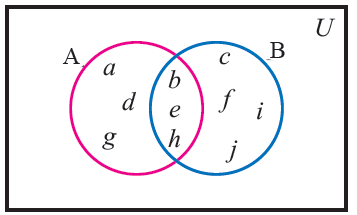
Solution :
The variables inside the circle A are known as elements of the set A.
A = { a, b, d, e, g, h }
The variables inside the circle B are known as elements of the set B.
B = { b, c, e, f, i, j, h }
The variables inside the circles A and B are known as elements of the set AUB.
A U B = { a, b, c, d, e, f, g, h, i, j }
The variables in the common region of A and B are known as elements of A n B.
A n B = { b, e, h }
To verify the given statement, we have to find the cardinal number of each set.
n (A) = 6
n (B) = 7
n (A U B) = 10
n (A n B) = 3
n(A U B) = n(A) + n(B) - n(A n B)
10 = 6 + 7 - 3
10 = 13 - 3
10 = 10
Hence it is proved.
Question 2 :
If n(U) = 38, n(A) = 16, n (AnB) = 12, n(B') = 20 find n(AUB) .
Solution :
n (A U B) = n (A) + n (B) - n (A n B)
n (B) = n (U) - n (B')
n (B) = 38 - 20 ==> 18
n (A U B) = n (A) + n (B) - n (A n B)
n (A U B) = 16 + 18 - 12
= 34 - 12
= 22
Hence the value of n (A U B) is 22.
Question 3 :
From the given Venn diagram find
(i) A (ii) B (iii) A U B (iv) A n B
Also verify that n(A U B) = n(A) + n(B) - n(A n B)
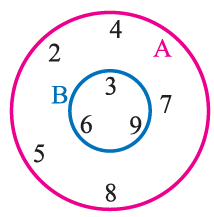
Solution :
The numbers inside the circle A are known as elements of set A.
A = { 2, 3, 4, 5, 6, 7, 8, 9 }
n (A) = 8
The numbers inside the circle B are known as elements of set B.
B = { 3, 6, 9 }
n (B) = 3
The numbers inside the circles A and B are known as elements of the set AUB.
A U B = { 2, 3, 4, 5, 6, 7, 8, 9 }
n (A U B) = 8
The numbers in common region of A and B is known as elements of A n B.
A n B = {3, 6, 9}
n (A n B) = 3
n(A U B) = n(A) + n(B) - n(A n B)
8 = 8 + 3 - 3
8 = 8
Hence it is proved.
Question 4 :
From the venn diagram, write the elements of set A n B

Solution :
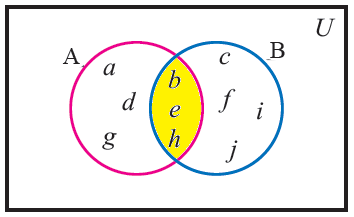
The variables in common region of A and B are known as elements of A n B.
A n B = { b, e, h }
Question 5 :
If n(A) = 12, n(B) = 17 and n(A U B) = 21, find n(A n B)
Solution :
By using the formula,
n(A U B) = n (A) + n (B) - n (A n B)
we may find the value of n (A n B)
21 = 12 + 17 - n (A n B)
21 = 29 - n (A n B)
n (A n B) = 29 - 21 ==> 8
Hence the value of n (A n B) is 8.
Question 6 :
From the venn diagram, write the elements of the following sets
(i) A' (ii) B' (iii) (A n B)' (iv) (A U B)'

Solution :
(i) A'
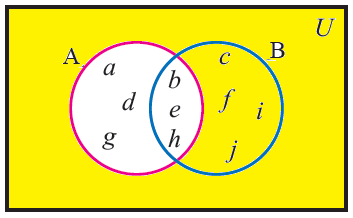
A' = { c, f, i ,j }
(ii) B'
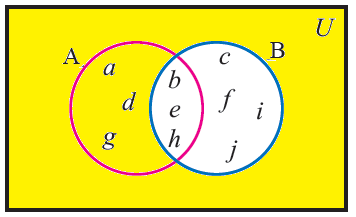
B' = { a, d, g }
(iii) (A n B)'
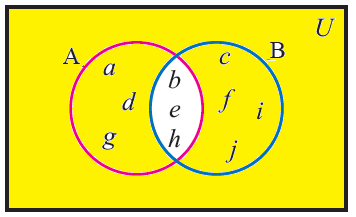
(A n B)' = { a, d, g, c, f, i, j }
(iv) (A U B)'
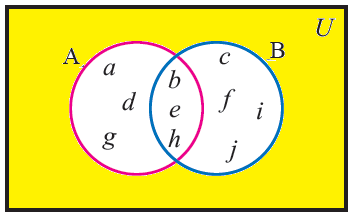
(A U B)' = { } (or) null set
Question 7 :
If n(U) = 43, n (A) = 26 find n (A')
Solution :
By using the formula,
n (A) + n (A') = n (U)
we may find the value of n (A')
26 + n (A') = 43
Subtract 26 on both sides
26 - 26 + n (A') = 43 - 26
n (A') = 17
Question 8 :
If n (U) = 38, n (A) = 16, n (A n B) = 12, n (B') = 20, find n (A U B).
Solution :
By using the formula,
n (B) + n (B') = n (U)
we may find the value of n (B')
n (B) + 20 = 38
Subtract 20 on both sides
n (B) + 20 - 20 = 38 - 20
n (B) = 18
n (A U B) = n (A) + n (B) - n (A n B)
= 16 + 18 - 12
= 34 - 12
= 22
Question 9 :
If A = {- 2, - 1,0,3,4}, B = {- 1,3,5}, find (i) A - B (ii) B - A
Solution :
A = {- 2, - 1,0,3,4} and B = {- 1,3,5}
A - B = { -2, 0, 4}
B - A = { 5 }
Question 10 :
If A = {2, 3, 5, 7, 11} and B = {5, 7, 9, 11, 13} , find A Δ B.
Solution :
A = {2, 3, 5, 7, 11} and B = {5, 7, 9, 11, 13}
A - B = { 2, 3 }
B - A = { 9, 13 }
A Δ B = (A - B) U (B - A)
= { 2, 3, 9, 13 }
Question 11 :
Given that U = {3, 7, 9, 11, 15, 17, 18}, M = {3, 7, 9, 11} and N = {7, 11, 15, 17},
find (i) M - N (ii) N - M (iii) N' - M (iv) M' - N
(v) M n (M - N) (vi) N U (N - M) (vii) n(M - N)
Solution :
U = { 3, 7, 9, 11, 15, 17, 18 }
M = { 3, 7, 9, 11 }
N = { 7, 11, 15, 17 }
(i) M - N
The set M - N would contain the elements of the set M excluding the elements of M n N
M - N = { 3, 9 }
(ii) N - M
The set N - M would contain the elements of the set M excluding the elements of N n M
N - M = { 15, 17 }
(iii) N' - M
N' = { 3, 9, 18 }
N' - M = {18}
(iv) M' - N
M' = { 15, 17, 18 }
M' - N = { 18 }
(v) M n (M - N)
The set M n (M - N) would contain the set of common elements that we found in both the set M and (M - N)
M = { 3, 7, 9, 11 } M - N = { 3, 9 }
M n (M - N) = { 3, 9}
(vi) N U (N - M)
N = { 7, 11, 15, 17 } N - M = { 15, 17 }
N U (N - M) = { 7, 11, 15, 17 }
(vii) n(M - N)
Number of elements of set M - N is 2.
Hence n(M - N) = 2
Kindly mail your feedback to v4formath@gmail.com
We always appreciate your feedback.
©All rights reserved. onlinemath4all.com
Recent Articles
-
Digital SAT Math Problems and Solutions (Part - 252)
Aug 10, 25 02:03 AM
Digital SAT Math Problems and Solutions (Part - 252) -
Digital SAT Math Problems and Solutions (Part - 251)
Aug 08, 25 09:19 PM
Digital SAT Math Problems and Solutions (Part - 251) -
Digital SAT Math Problems and Solutions (Part - 250)
Aug 08, 25 08:05 AM
Digital SAT Math Problems and Solutions (Part - 250)